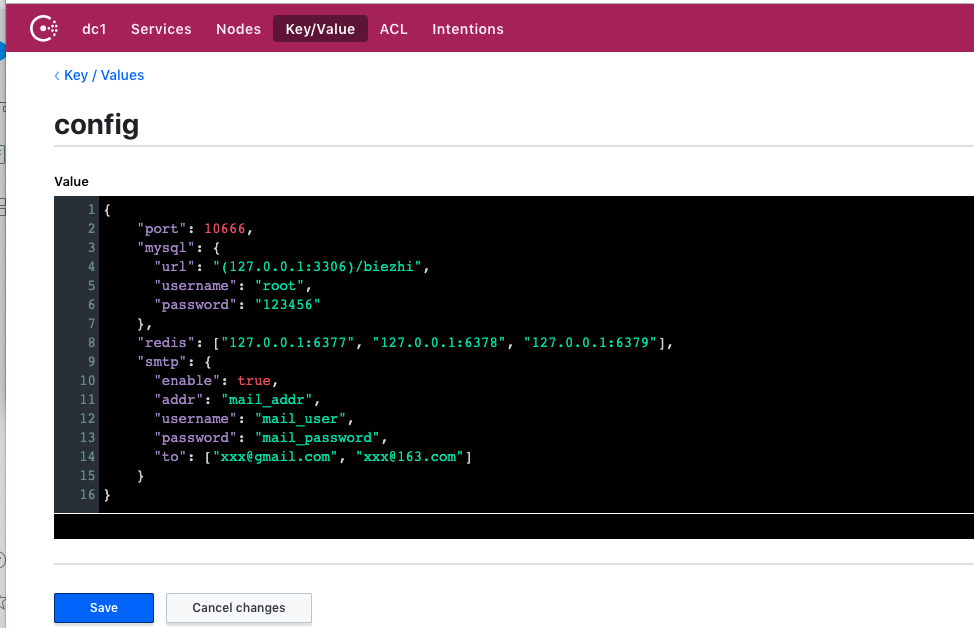viper
项目地址 :github.com/spf13/viper
go 开发工具,主要是用于处理各种格式的配置文件,简化程序配置的读取问题
viper 支持:
设置默认配置
支持读取 JSON TOML YAML HCL 和 Java 属性配置文件
监听配置文件变化,实时读取读取配置文件内容
读取环境变量值
读取远程配置系统 (etcd Consul) 和监控配置变化
读取命令 Flag 值
读取 buffer 值
读取确切值
1 2 go get github.com/fsnotify/fsnotify go get github.com/spf13/viper
json 配置文件 (config.json)
1 2 3 4 5 6 7 8 9 10 11 12 13 14 15 16 { "port" : 10666,"mysql" : { "url" : "(127.0.0.1:3306)/biezhi" , "username" : "root" , "password" : "123456" }, "redis" : ["127.0.0.1:6377" , "127.0.0.1:6378" , "127.0.0.1:6379" ],"smtp" : { "enable" : true , "addr" : "mail_addr" , "username" : "mail_user" , "password" : "mail_password" , "to" : ["[email protected] " , "[email protected] " ] } }
yaml 配置文件 (config1.yaml)
1 2 3 4 5 6 7 8 9 10 11 12 13 14 15 16 17 port: 10666 mysql: url: "(127.0.0.1:3306)/biezhi" username: root password: 123456 redis: - 127.0.0.1:6377 - 127.0.0.1:6378 - 127.0.0.1:6379 smtp: enable : true addr: mail_addr username: mail_user password: mail_password to: - [email protected] - [email protected]
将上述两个配置文件和下面的 main.go 放在统一目录之下,即可实现读取配置文件
1 2 3 4 5 6 7 8 9 10 11 12 13 14 15 16 17 18 19 20 21 22 23 24 25 26 27 28 29 30 31 32 33 34 35 package main import ( "fmt" "log" "github.com/spf13/viper" ) func init // viper.SetConfigName("config1" ) // 读取yaml配置文件 viper.SetConfigName("config" ) // 读取json配置文件 //viper.AddConfigPath("/etc/appname/" ) //设置配置文件的搜索目录 //viper.AddConfigPath("$HOME /.appname" ) // 设置配置文件的搜索目录 viper.AddConfigPath("." ) // 设置配置文件和可执行二进制文件在用一个目录 if err := viper.ReadInConfig(); err != nil { if _, ok := err.(viper.ConfigFileNotFoundError); ok { // Config file not found; ignore error if desired log.Println("no such config file" ) } else { // Config file was found but another error was produced log.Println("read config error" ) } log.Fatal(err) // 读取配置文件失败致命错误 } } func main fmt.Println("获取配置文件的port" , viper.GetInt("port" )) fmt.Println("获取配置文件的mysql.url" , viper.GetString(`mysql.url`)) fmt.Println("获取配置文件的mysql.username" , viper.GetString(`mysql.username`)) fmt.Println("获取配置文件的mysql.password" , viper.GetString(`mysql.password`)) fmt.Println("获取配置文件的redis" , viper.GetStringSlice("redis" )) fmt.Println("获取配置文件的smtp" , viper.GetStringMap("smtp" )) }
代码详解
viper.SetConfigName (“config”) 设置配置文件名为 config, 不需要配置文件扩展名,配置文件的类型 viper 会自动根据扩展名自动匹配.
viper.AddConfigPath (“.”) 设置配置文件搜索的目录,. 表示和当前编译好的二进制文件在同一个目录。可以添加多个配置文件目录,如在第一个目录中找到就不不继续到其他目录中查找.
viper.ReadInConfig () 加载配置文件内容
viper.Get*** 获取配置文件中配置项的信息
1 2 3 4 5 6 7 8 // set default config viper.SetDefault("ContentDir" , "content" ) viper.SetDefault("LayoutDir" , "layouts" ) viper.SetDefault("Taxonomies" , map[string]string{"tag" : "tags" , "category" : "categories" }) fmt.Println(viper.GetBool("ContentDir" )) fmt.Println(viper.GetString("LayoutDir" )) fmt.Println(viper.GetStringMapString("Taxonomies" ))
监听和重新读取配置文件
import “github.com/fsnotify/fsnotify”
1 2 3 4 5 viper.WatchConfig() viper.OnConfigChange(func(e fsnotify.Event) { //viper配置发生变化了 执行响应的操作 fmt.Println("Config file changed:" , e.Name) })
1 2 3 4 5 6 7 8 9 10 11 12 13 14 // AutomaticEnv has Viper check ENV variables for all. // keys set in config, default & flags AutomaticEnv() // BindEnv binds a Viper key to a ENV variable. // ENV variables are case sensitive. // If only a key is provided, it will use the env key matching the key, uppercased. // EnvPrefix will be used when set when env name is not provided. BindEnv(string…) : error // SetEnvPrefix defines a prefix that ENVIRONMENT variables will use. // E.g. if your prefix is "spf" , the env registry will look for env // variables that start with "SPF_" . SetEnvPrefix(string)
1 2 3 4 5 6 7 8 9 10 11 12 13 14 15 16 17 18 19 20 21 22 23 24 25 26 27 28 29 package main import ( "fmt" "os" "github.com/spf13/viper" ) func main prefix := "PROJECTNAME" envs := map[string]string{ "LOG_LEVEL" : "INFO" , "MODE" : "DEV" , "MYSQL_USERNAME" : "root" , "MYSQL_PASSWORD" : "xxxx" , } for k, v := range envs { os.Setenv(fmt.Sprintf("%s_%s" , prefix, k), v) } v := viper.New() v.SetEnvPrefix(prefix) v.AutomaticEnv() for k, _ := range envs { fmt.Printf("env `%s` = %s\n" , k, v.GetString(k)) } }
使用 github.com/spf13/viper/remote 包 import _ “github.com/spf13/viper/remote”
Viper 可以从例如 etcd、Consul 的远程 Key/Value 存储系统的一个路径上,读取一个配置字符串(JSON, TOML, YAML 或 HCL 格式). 这些值优先于默认值,但会被从磁盘文件、命令行 flag、环境变量的配置所覆盖.
本人对 consul 比较熟悉,用它来做例子
代码如下
1 2 3 4 5 6 7 8 9 10 11 12 13 14 15 16 17 18 19 20 21 22 23 24 25 26 package main import ( "fmt" "log" "github.com/spf13/viper" _ "github.com/spf13/viper/remote" ) func main v := viper.New() v.AddRemoteProvider("consul" , "localhost:8500" , "config" ) v.SetConfigType("json" ) // Need to explicitly set this to json if err := v.ReadRemoteConfig(); err != nil { log.Println(err) return } fmt.Println("获取配置文件的port" , v.GetInt("port" )) fmt.Println("获取配置文件的mysql.url" , v.GetString(`mysql.url`)) fmt.Println("获取配置文件的mysql.username" , v.GetString(`mysql.username`)) fmt.Println("获取配置文件的mysql.password" , v.GetString(`mysql.password`)) fmt.Println("获取配置文件的redis" , v.GetStringSlice("redis" )) fmt.Println("获取配置文件的smtp" , v.GetStringMap("smtp" )) }
1 2 3 4 5 6 7 8 9 10 11 12 13 14 15 16 17 18 19 20 21 22 23 24 25 26 27 28 29 30 31 32 33 34 35 36 37 38 39 40 41 42 package main import ( "bytes" "fmt" "github.com/spf13/viper" ) func main v := viper.New() v.SetConfigType("json" ) // 设置配置文件的类型 // 配置文件内容 var jsonExample = []byte(` { "port" : 10666, "mysql" : { "url" : "(127.0.0.1:3306)/biezhi" , "username" : "root" , "password" : "123456" }, "redis" : ["127.0.0.1:6377" , "127.0.0.1:6378" , "127.0.0.1:6379" ], "smtp" : { "enable" : true , "addr" : "mail_addr" , "username" : "mail_user" , "password" : "mail_password" , "to" : ["[email protected] " , "[email protected] " ] } } `) //创建io.Reader v.ReadConfig(bytes.NewBuffer(jsonExample)) fmt.Println("获取配置文件的port" , v.GetInt("port" )) fmt.Println("获取配置文件的mysql.url" , v.GetString(`mysql.url`)) fmt.Println("获取配置文件的mysql.username" , v.GetString(`mysql.username`)) fmt.Println("获取配置文件的mysql.password" , v.GetString(`mysql.password`)) fmt.Println("获取配置文件的redis" , v.GetStringSlice("redis" )) fmt.Println("获取配置文件的smtp" , v.GetStringMap("smtp" )) }
这个功能日常的使用情况较少,例如这样的一个情景:
配置文件放在 oss 上或者 github 某个私有仓库上,viper 并没有提供直接的接口去获取,这样我们可以基于第三方托管平台的 sdk 写一套获取配置文件 bytes 的工具,将结果放入 io.Reader 中,再进行配置文件的解析。
上述流程感觉好像比较鸡肋,复杂了整个流程:我既然可以通过第三方的 sdk 直接拿到 bytes,为何不自己直接进行解析呢?而要借助 viper 来解析。可能有人会说,配置文件如果格式不同呢?确实,viper 的出现就是为了针对多种格式的配置文件。但是在正式的项目中,配置文件的格式一般不会变,可以自己写一套解析的工具,也就没有使用 viper 的需求了。而且对于某一种特定格式的配置文件(JSON,YAML…),Golang 已经有足够强大的包来进行解析了。
但是不得不承认 viper 的实现确实是很流弊的。在一般的快速开发过程中,直接使用 viper 确实可以帮助我们省去很多的麻烦,让我们集中精力针对于业务逻辑的实现。
个人觉得可以根据实际需求在 viper 再进行一层封装,接入一些常用的第三方平台的 sdk(github,aliyun oss…), 这样即可以读取本地配置文件,也可以读取远端的配置文件,可以通过命令行参数来实现 dev 模式和 deploy 模式的切换。
-------------The End-------------
subscribe to my blog by scanning my public wechat account
文章来源: https://cloudsjhan.github.io/2019/12/23/viper%E9%85%8D%E7%BD%AE%E8%AF%A6%E8%A7%A3/


